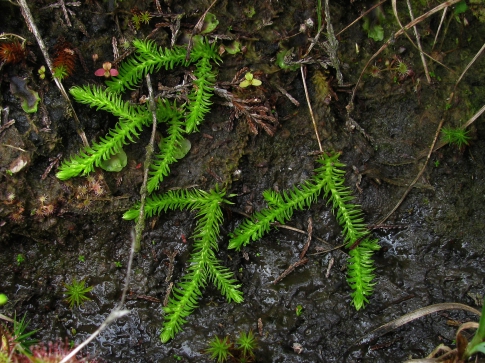News
2015-11-11
Biological monitoring on plants: encouraging results in the Ardennes (F)
The feedback of the Forests National Office (ONF) is very clear: the results of plant inventories after actions of the LIFE Elia-RTE are very encouraging ! This is what arises from actions carried out by the project, in close cooperation with French TSO RTE, in the Mazures forest and communal forest of Hargnies in the Ardennes department (08), France.
Heavy work on site...but for a better nature
Brief disruptions of vegetation associated with heavy work restoration can sometimes trigger questions, but when the results are there, we must face the facts. Inventories made by the ONF on the LIFE site perfectly illustrate the interest of wetland restoration works that started in 2013.

Figure 1. Lycopodium and Drosera after our restoration work (picture Alain Mora)
Presentation of sites and restoration actions
The two working areas are located south of Givet, in Mazures' forest and the communal forest of Hargnies.

Figure 2. Map of Mazures site

Figure 3. Map of Hargnies site
A set of actions were carried out there, such as the digging of ponds, soil removals (superficial soil stripping), restoration of wetland habitat ... These sites had also been visited by the European Commission in October 2014.
Actions in detail:
A. Mazures: actions on 2 ha in 2013
B. Hargnies: over 4 ha of restored bogs and digging of 9 ponds in 2014

Figure 4. Photo of actions in Hargnies

Figure 5. Photo of actions in Hargnies
Results of biological monitoring in 2015
Following the works carried out in 2013, it was important to assess the evolution of natural habitats and their colonization by flora and fauna. This assessment is done through an effective partnership with the ONF, naturalist experts and the Regional Natural Park of the Ardennes.
One year after completion of the work (just over the Mazures), botanists have made nice discovering ! The situation before starting the work did not show a great diversity of flora: dominance of Molinia, purple moor-grass in wetlands and Eagle fern dominance in the drier moorland. Today, these species gave way to a succession of outstanding natural habitats of Community interest (Natura 2000 protected habitats of Europe), hosting rare and protected species.
Sphagnum is back in the Mazures
The bare humid ground now hosts sphagnum patches, sometimes more than 10 cm thick. This moss is the driving force of a very slow peat decomposition process, typical of acidic habitats.

Figure 6. Sphagnum (Sphagnum sp)
Besides Sphagnum (several different species) twenty other species of bryophytes have been identified, along with many species of sedge (Carex spp.). And even the swamp cinquefoil (Comarum palustre, an heritage specie), which has taken its place in the Mazures, the feet in the water!

Figure 7. Swamp cinquefoil (Comarum palustre)
The marsh clubmoss in Hargnies
A Hargnies, plant diversity is also impressive. Higher plants such as cotton grass have been spotted, where purple moor-grass was before, but the biggest surprise is the discovery of club marsh or inundated club moss bogs (Lycopodiella inundata )) which had not been seen in the region for over a century! It is interesting to note the status given by some French botanical conservatories on the population, "In general decline; become rare or even exceptional, not seen for a long time in many areas. Most stations are in very precarious situations "! A real success for our actions and confirmed by the inventories.

Figure 8. Marsh clubmoss (Lycopodiella inundata)
With the limitation of purple moor-grass and eagle ferns, we can foresee the return of iconic species.
Thanks to field species
We take the opportunity to thank the Franco-Belgian team of botanists and bryologists who realized inventories, namely Michel Colcy from the ONF and Bernadette Alain Mora (who kindly provided photos of illustrations), and André Sotiaux Patrick Degroote for effective partnership that can highlight the work of the LIFE project in consultation with local partners. The results are a complete success. A nice collaboration with field teams RTE also!

